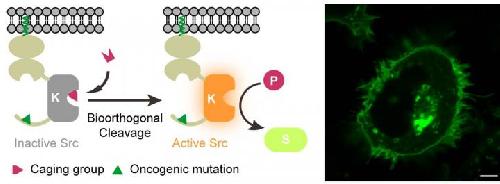In the alphabets of our genomes, a single typo can mean the difference between health and disease. The "words" are molecules, like enzymes, and one group of these called kinases are particularly important. However, it's difficult to pick apart the exact roles of misspellings in various kinases in a disease process. This week in ACS Central Science, researchers report development of a new way to determine this, both in a lab dish and in mice.
Traditionally, biologists study an enzyme's function by turning it off, usually with a drug. But because kinases have so many similarities, that's difficult to do in a specific way. An alternative is to turn one on to see what it does, but this has required complicated methods. So Peng Chen and colleagues engineered a genetically encoded chemical "block" that can be removed from the kinase with a paired chemical reaction. After turning the enzyme on, Chen and colleagues can investigate the activity of any kinase, including one called, Src, which, when mutated, causes cancer. In addition, it works not only in cells but in whole animals where existing "turn on" tools often fail.
 With a brand-new approach, researchers can turn on kinases, such as Src above, to learn more about how they work. Credit: American Chemical Society
With a brand-new approach, researchers can turn on kinases, such as Src above, to learn more about how they work. Credit: American Chemical Society
source: American Chemical Society